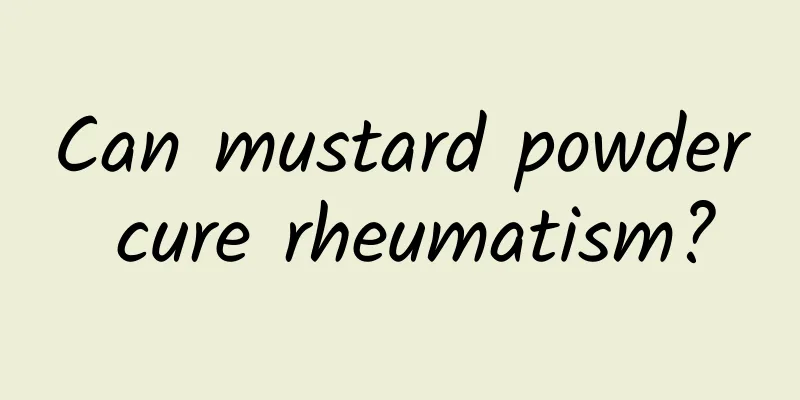What to do if your skin is red, itchy and swollen

|
Our skin is very fragile and will react to various stimuli, causing symptoms such as itching and pain. The phenomenon of red, itchy and swollen skin is likely to be urticaria, which may disappear on its own, but it is easy to recur and can last for several months. The solution is the most concerning. So, what should you do if your skin is red, itchy and swollen? Let’s take a closer look below. Causes The cause of urticaria is very complicated, and the cause cannot be found in about 3/4 of patients, especially chronic urticaria. The common causes include: food and food additives; inhalants; infection; drugs; physical factors such as mechanical stimulation, cold and heat, sunlight, etc.; insect bites; mental factors and endocrine changes; genetic factors, etc. treat 1. General treatment Because the causes of urticaria vary, the treatment effects are also different. The specific treatment measures are as follows: (1) Eliminate the cause. Every patient should strive to find the cause of the attack and avoid it. If the cause is infection, the infected lesions should be treated actively. If the allergy is caused by drugs, the allergy medication should be stopped; if the allergy is caused by food, find out the allergic food and do not eat this food again. (2) Avoid inducing factors. For example, for cold urticaria, you should keep warm; for acetylcholine urticaria, you should reduce exercise, sweating and mood swings; for contact urticaria, you should reduce the chance of contact. 2. Medication (1) Antihistamine drugs ①H receptor antagonists have strong anti-histamine and anti-other inflammatory mediator effects and are effective in treating various types of urticaria. Commonly used H1 receptor antagonists include diphenhydramine, cyproheptadine, chlorpheniramine, acrivastine, cetirizine, mizolastine, loratadine, ebastine, azelastine, desloratadine, etc.; when single treatment is ineffective, two different types of H1 receptor antagonists can be used in combination or in combination with H2 receptor antagonists. Commonly used H2 receptor antagonists include cimetidine, ranitidine, famotidine, etc. It is effective for acute, chronic urticaria and cold urticaria. Dosage varies from person to person. ② Doxepin is a tricyclic antidepressant that is particularly effective for chronic urticaria and has fewer adverse reactions. Doxepin is a better choice of drug for patients with urticaria who are not responsive to traditional antihistamines. (2) Drugs that inhibit mast cell degranulation and reduce histamine release ① Meta-hydroxyisobutyrine sulfate is a β2 adrenergic receptor stimulator that can increase the concentration of cAMP in the body, thereby inhibiting mast cell degranulation. ② Ketotifen inhibits mast cell degranulation and prevents the release of inflammatory mediators (such as histamine, slow-reacting substances, etc.) by increasing the concentration of cAMP in the body. Its suppressed. It is stronger and faster than sodium cromoglycate and can be taken orally. ③Sodium cromoglycate can block the binding of antigen and antibody and inhibit the release of inflammatory mediators. If used in combination with glucocorticoids, the dosage of the latter can be reduced and the therapeutic effect can be enhanced. ④ Tranilast reduces the release of histamine by stabilizing the mast cell membrane. (3) Glucocorticoids It is a second-line drug for the treatment of urticaria. It is generally used when severe acute urticaria, urticarial vasculitis, pressure urticaria are ineffective with antihistamines, or when chronic urticaria is severely stimulated. It is given by intravenous drip or orally, and long-term use should be avoided. Commonly used drugs are as follows: ① prednisone; ② triamcinolone; ③ dexamethasone; ④ diprosone. In emergency situations, hydrocortisone, dexamethasone, or methylprednisolone is given intravenously. (4) Immunosuppressants When patients with chronic urticaria have an autoimmune basis, the disease recurs, and the above treatments cannot achieve satisfactory results, immunosuppressants can be used. Cyclosporine has a good therapeutic effect. Azathioprine, cyclophosphamide, methotrexate and immunoglobulin can all be tried. Tripterygium wilfordii also has a certain therapeutic effect. Due to the high incidence of side effects of immunosuppressants, they are generally not recommended for the treatment of urticaria. In addition, drugs that reduce vascular permeability, such as vitamin C, vitamin P, calcium supplements, etc., are often used in combination with antihistamines. If it is caused by infectious factors, appropriate antibiotics can be used for treatment. |
>>: Can sebaceous cysts be squeezed out by themselves?
Recommend
What to do if you have arrhythmia? Expert recommended treatment
Arrhythmia is a type of heart disease. Arrhythmia...
Treatment of Melasma
There are many common diseases. In the treatment ...
How to eat saffron
People who care about health know that rose tea i...
Causes of swollen feet
Swollen feet is a phenomenon that many people wil...
Pingyangmycin for the treatment of hemangioma
Pingyangmycin is widely used in today's medic...
What are blackheads and fat particles squeezed out?
Blackheads are quite common in our daily life and...
What is vocal cord leukoplakia? Why do white spots appear on the vocal cords?
The medical term vocal cord leukoplakia is very u...
What fungus causes athlete's foot?
Fungal infection is the direct cause of athlete&#...
The difference between Perennial Cortex and Acanthopanax Cortex
Both Acanthopanax Cortex and Cyperus rotundus Cor...
Pain inside the ears is not always caused by heat, so be careful if you have this symptom!
Does ear pain necessarily mean it’s caused by inf...
What fruits can eliminate acne?
Acne is the natural enemy of those who love beaut...
Symptoms of urinary retention, beware of abnormal urination
The most common type of urinary retention is acut...
Chinese medicine massage techniques, Chinese medicine massage should pay attention to
Tuina massage is a treatment method in Traditiona...
How to sleep better when you are 6 months pregnant? What are the health care common sense?
Generally speaking, when the pregnancy reaches ab...
Can I smoke if I have gastric bleeding?
Gastric bleeding is a relatively serious symptom....









